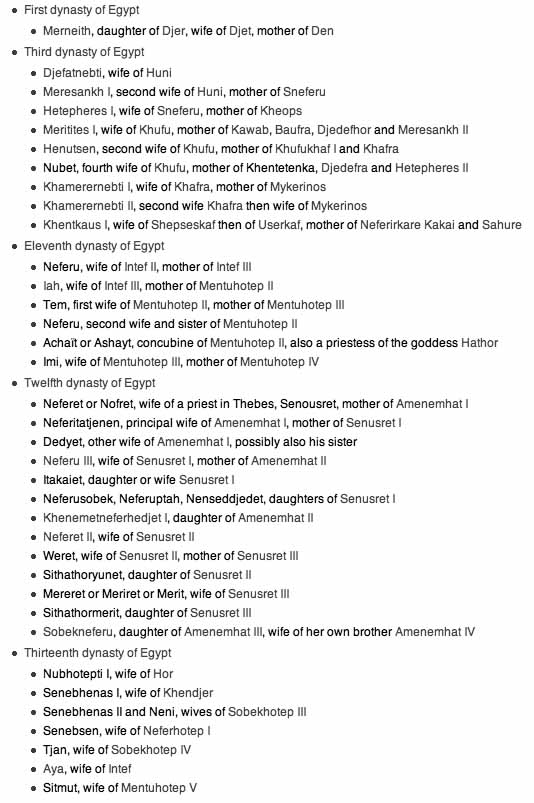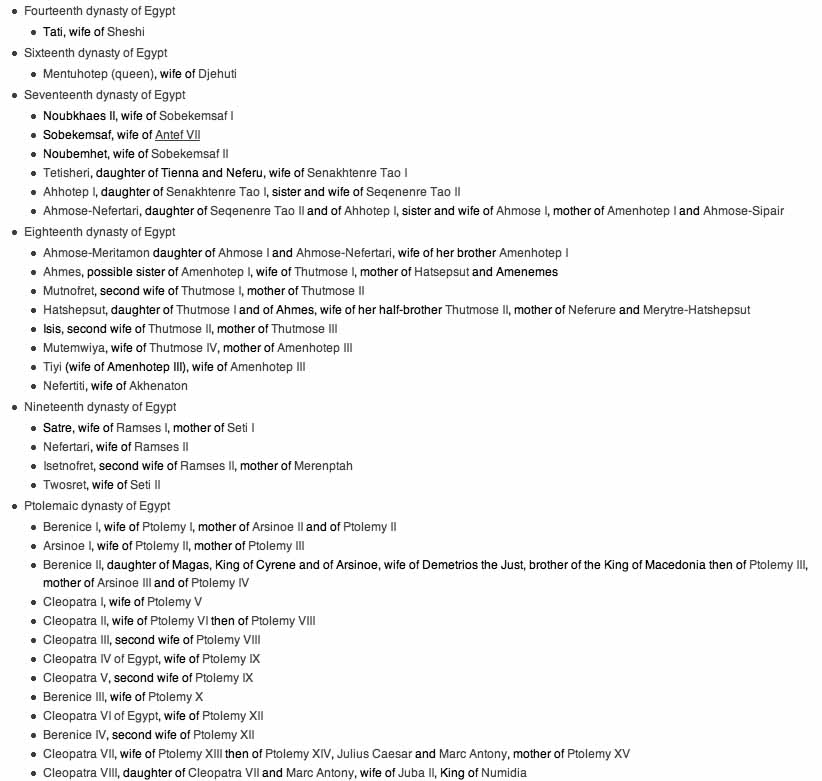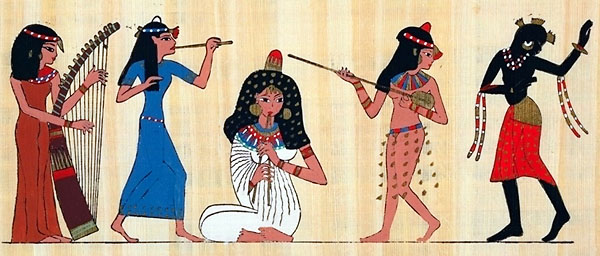

Women in Ancient Egypt had a status that may seem surprisingly modern when compared to the status women occupied in the majority of contemporary societies. Although men and women had traditionally distinct powers in society, it seems that there was no insurmountable barrier in front of those who wanted to deviate from this pattern. Egyptian society recognized women not as equal to men, but as having an essential complementarity, expressed especially in the action of producing children. This respect is expressed clearly in the Ancient Egyptian theology and morality, but it is certainly quite difficult to determine the extent of its application in the daily life of Egyptians. However, it was far different from the society of Ancient Greece where women were considered eternal legal minors.
Compared with their counterparts in ancient Greece, Rome, and even more modern places around the world, ancient Egyptian women had a greater range of personal choices and opportunities for achievement. Women such as Hatshepsut and Cleopatra VI even became pharaohs, while others wielded power as Divine Wives of Amun. Despite these freedoms, ancient Egyptian women did not often take part in official roles in the administration, served only secondary roles in the temples, and were not as likely to be as educated as men.
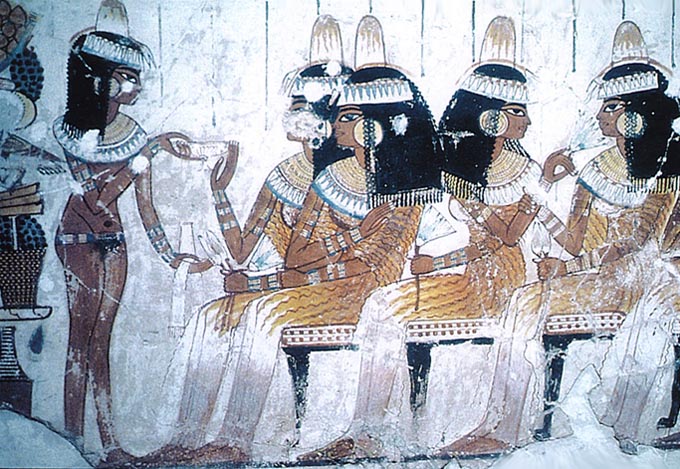
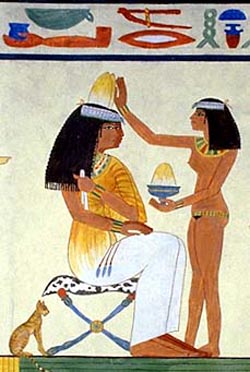
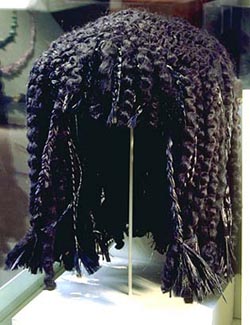
The Egyptians cared about their appearance. The women spent a lot of time bathing, rubbing oils and perfumes into their skin, and using their many cosmetic implements to apply make-up and style their wigs, worn by men and women. A woman would place a cone made of fat soaked in sweet smelling ointment on her head, which slowly melted over her wig during a warm evening. Men were always clean-shaven, using razors made from bronze to shave their beards and heads.
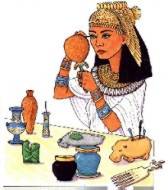
Both men and women wore blue and green eyeshadow and black eyeliner. Using a highly-polished bronze hand mirror, a woman would apply khol, a black dye kept in a jar or pot, to line her eyes and eyebrows, using an "brush" or "pencil" made of a reed. Men also wore this eye make-up as well, which was not only a fashion but also protected against the eye infections which were common in Egypt.
They would use a dye called henna to redden their nails and lips.
Current knowledge of Ancient Egypt indicates that Egyptian women were the equal of men under the law (unlike Greco-Roman or Mesopotamian women during the same period). Thus, they could own land, manage their own property and represent themselves in court cases. They could sit on juries and testify in trials. At the same time, they were also subject to the same legal penalties as men. She could divorce, initiate a lawsuit to recover the assets of the household and win the case, which did not prevent her from remarrying, as shown by the archaeological data on the Jewish community of Elephantine found in the Elephantine papyri.
Marriages were often arranged by the fathers of the bride and groom, but it was not rare for spouses to make their own choice. Normally the fathers of the bride and groom would arrange a pre-nuptual contract between the future spouses. The purpose of the pre-marital contract was to specify what allowance the wife would be entitled to receive from her husband, as well as what presents the groom was expected to give to his wife and her parents. The contract specifies any property or goods that the wife brings with her, and they remain hers in the case of divorce. There was no dowry expected from the bride's father, another significant difference with other societies in the region.
By marrying, the Egyptian woman kept her name with the added-on surname "wife of X". Marriage appears to have been perceived as a natural state, and it seems that it did not result from an administrative process or a religious event; it often embodies the will of a man and a woman to live together, which does not prevent the possible existence of a material marriage contract in the future, as was often the case elsewhere. As Christiane Desroches Noblecourt emphasizes, "marriage and eventually divorce are events sanctioned in the family environment only by the will of the spouses, without any intervention by the Empire's bureaucracy"; the bride and groom pronounced the phrases: "I make you my wife" and "You make me your wife".
Men were obligated to guarantee the well-being of their spouse in material ways. The scribe Ani (during the New Kingdom period) advised future spouses :
Certainly, things did not always proceed in an ideal fashion and divorce existed. It began on the initiative of one or the other spouse. If the initiative came from the husband, it had to cede part of his goods to his wife; if the women took the initiative, she was held to the same obligation but to a lesser degree. Recourse to a tribunal was possible in the case of a contested divorce between the spouses, although the Empire's bureaucracy did not intervene in the act of marriage.
The great hymn to Isis written in the Oxyrhynchus Papyri expresses this equality between men and women, addressing the goddess with "the honor of the feminine sex" -- "it is you, the mistress of the earth ... you have given women power equal to that of men".
Christiane Desroches Noblecourt :

Kitchen model; women workers grinding, baking and brewing. Bread- and beer-making (made of fermented bread) were usually women's tasks. Twelfth dynasty of Egypt, 2050-1800 BCE. Egyptian Museum of Berlin.
Most women belonged to the peasantry, and worked alongside their husbands doing agricultural work. Women were known to manage farms or businesses in the absence of their husbands or sons. Among the upper classes of society, a woman usually did not work outside the home, and instead supervised the servants of the household and her children's education.
Women belonging to families wealthy enough to hire nannies to help with childcare frequently worked as perfume-makers, and also were employed in courts and temples, as acrobats, dancers, singers, and musicians, which were all considered respectable pursuits for upper-class women. Women belonging to any class could work as professional mourners or musicians, and these were common jobs.
Noblewomen could be members of the priesthood connected to either a god or goddess. Women could even be at the head of a business as, for example, the lady Nenofer of the New Kingdom, and could also be a doctor, like the lady Peseshet during the Fourth dynasty of Egypt.

Wall relief showing childbirth, Treasure Hall, Temple of Edfu
There is much evidence of complex beliefs and practices in Ancient Egypt related to the important role fertility played in society. Religious beliefs included rules concerning purification, similar to other religions in the region. Women in Egypt were believed to be eliminating impure elements during menstruation, and were excused from work and could not enter the restricted rooms of temples while menstruating.
Fertility rituals were used by couples desiring children. Contraception was permitted as well, and medical texts survive that refer to many contraceptive formulas (although the ingredients are often now difficult to identify). Some formulas, such as drinks made of celery base and beer, are dubious, but others show a basic knowledge of somewhat effective methods, such as a spermicide made of fermented acacia gum, which produces a sperm-killing lactic acid.
Once pregnant, the uterus was placed under the protection of a specific goddess, Tenenet. Ritual medical care was given by anointing the woman's body with beneficial oils, using a small bottle in the form of a woman posed with her hands placed on a round belly. There was a ritual formula practiced by Egyptians wanting to know the sex of their baby, which spread to Greece, Byzantium, and then to Europe, where it was practiced for centuries without anyone realizing its origins in Ancient Egypt. It involves placing grains of barley and wheat in a cloth sachet and soaking them in the pregnant woman's urine; if barley sprouted first, the baby was said to be a boy, and if the wheat sprouted first, the baby was said to be a girl. In Ancient Egypt, the word for barley was the synonym of "father".
When it was time for childbirth, the pregnant woman was assisted by midwives. She would be shaved, including her head. The midwives would support the woman during labour while she remained in a squatting position on a mat. On the corners of the mat were placed four bricks, believed to be the incarnation of four goddesses: Nut (goddess), the great goddess of the sky; Tefnut, the elder, the feminine polarity of the first couple; Isis the beautiful; and Nephtys, the excellent.


Old Kingdom Egyptian princess Nefertiabet (2590-2565 BCE) from
her tomb at Giza, painting on limestone, now in Louvre Museum
Few ancient civilizations enabled women to achieve important social positions. In Ancient Egypt, there are not only examples indicating women high officials were not so rare, but more surprising (for its time), there are women in the highest office, that of Pharaoh. More than a kind of feminism, this is a sign of the importance of theocracy in Egyptian society.
Egyptian society of antiquity, like many other civilizations of the time, used religion as a foundation for society. This was how the throne of the power of the Pharaohs was justified, as anointed by the gods, and the holder of the throne had a divine right. Typically, in ancient societies power was transferred from one male to the next. The son inherited the power, and in cases where the king did not have a son, the throne was then inherited by the male members of the family further removed from the king, such as cousins or uncles. But even if the monarch had daughters, they could not gain power.
In Egyptian civilization, this obligation of passing power to a male successor was not without exceptions. Royal blood, a factor determined by divine legitimacy, was the unique criteria for access to the throne. However, the divine essence was transmitted to the royal spouse, as was the case with Nefertiti, wife of Akhenaton.
Egyptians preferred to be governed by a woman with royal blood (being divine according to mythology) rather than by a man who did not have royal blood. Also, during crises of succession, there were women who took power. When this happened, the female Pharoah adopted all of the masculine symbols of the throne. There even exist doubts, in some instances, about the sex of certain Pharoahs who could have been women.
During the Eighteenth dynasty of Egypt, when Amenhotep I died, his successor Thutmose I appears to have not been his son, at least he was not the child of a secondary wife of the late Pharaoh; if his wife Ahmes was related to Amenhotep I, this union permitted divine legitimacy. For the following successor, princess Hatsepsut, daughter of Thutmose I and the Great Royal Wife, enabled Thutmose II, son of his second wife and therefore half-brother of the princess, to gain the throne by marrying him.
It was not rare for women to gain the throne in Ancient Egypt, as with Hatsepsut, who took the place of her nephew Thutmose III. When Hatsepsut inherited the throne from her late husband and became Pharaoh, her daughter Neferure took on a role that exceeded the normal duties of a royal princess, acquiring a more queenly role. There were also the Cleopatras, of whom the most well-known is Cleopatra VII (69 BCE to 30 BCE), famous for her beauty and her relationships with Julius Caesar and then Marc Antony, the leaders who depended upon her throne.
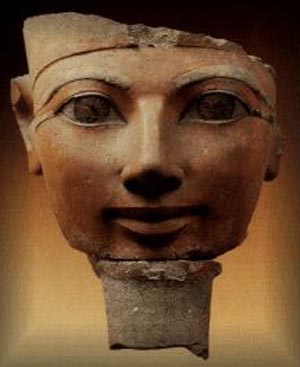
The women Pharaohs who are most well-known, and of whom historians are most certain, are the following:
Sobekneferu (Twelfth dynasty of Egypt),
Hatsepsut (Eighteenth dynasty of Egypt),
Neferneferuaten (Eighteenth dynasty of Egypt),
Twosret (Nineteenth dynasty of Egypt)

Many of the Great Royal Wives also played significant diplomatic and political roles:
Elsewhere in the New Kingdom, the Great Wife was often invested with a divine role: "Wife of god", "Hand of god". Hatchepsut was the first Great wife (of Thutmose II) to receive this latter title.
For women holding office in the highest levels of the bureaucracy, one can cite Nebet, a Vizir in Ancient Egypt during the Sixth dynasty of Egypt. It is necessary to recognize that a woman at such a high level of authority remained extremely rate and it was not until the Twenty-sixth dynasty of Egypt that a similar situation can be found. Women did, however, occupy numerous offices such as scribe in the bureaucracy, except during the New Kingdom, where all public bureaucracy posts were filled by men. There was also the Divine Adoratrice of Amun, granted major spiritual power, but also a power restricted to Thebes.
The literature of Ancient Egypt did not hesitate to present women as frivolous, capricious, and rarely trustworthy. But despite this, women benefitted from a status that was rare in the civilizations of the time.
While the painters and sculptors gave to women a serene image as part of a happy family, the writers were not tender, and they portrayed women as being the origin of misfortune and guilty of many sins (where one can see a form of the myth of Eve and the apple, or Pandora).
As Gaston Maspero describes in Contes populaires (Popular Tales), there was the fatal misadventure of Bytaou, the humble farmhand at the home of his brother Anoupou. Seduced by the wife of his brother, he succumbs to the charm of her beauty. She does not hesitate to denounce him to Anoupou, lying and never ceasing until she obtains the ultimate punishment for Bytaou at the hands of Anoupou. But she is punished in turn; Anoupou discovers much later that he has been played for a fool by his wife, who he kills, and throws her body to the dogs.
It is important not to interpret this incorrectly: the rarely flattering portrayal of women in Egyptian literature does not reveal for nothing that women were despised. The Pharaoh was often given the same treatment by storytellers who presented the Pharoah as a stubborn and whimsical character.
Men were invited to cherish their wives. Ptahhotep - an ancient Egyptian official during the late 25th century BC and early 24th century BC- expressed this in the following maxim (written in the Papyrus Prisse): "You must love your wife with all your heart ... make her heart happy as long as you live".
In the abundance of divinities in Egyptian mythology, there existed a large number of goddesses, as was also the case in Greece. By studying their symbolism we learn the image that women had in the eyes of the Ancient Egyptians. As with Greek divinities, many were related to one another, by blood or marriage, such as Isis and her sister Nephtys, both the respective wives of Osiris (the god of the dead) and of Seth, themselves brothers.
Women and their image were most often associated with life and fertility. In the case of the goddess Isis, who was associated with many principles: as the wife of Osiris who was killed by his brother, she was connected to funeral rites. As a mother, she became the feminine protector, but above all the mother-creator, she who gives life. Through this goddess, the principles of life and death were closely linked.
In effect, while she was associated with funeral rites, it must be noted that these rites were to prevent the deceased from submitting to a second death in the succeeding dimension, which explains among other things, the food found in abundance by archeologists in the tombs. On the other hand, life in its physical aspect meaningful only by death, because these principles are part of a movement of eternal new beginning that is then in a sense more spiritual, the movement of life, or eternal life. A symbol of the goddess is also the palm tree, the symbol of eternal life. She breathed the breath of eternal life to her dead husband.
The goddess represented the era's regard for women, because it was crucial to maintain the spirit in her image, it was this idea of eternal life and of maturity that Isis reflected, venerated as the Celestial Mother. It was in this role that Isis was arguably made the most important deity of Egyptian mythology. Her influence even extended to religions of different civilizations, where she would become identified under different names and where her cult grew, particularly in the Roman Empire.
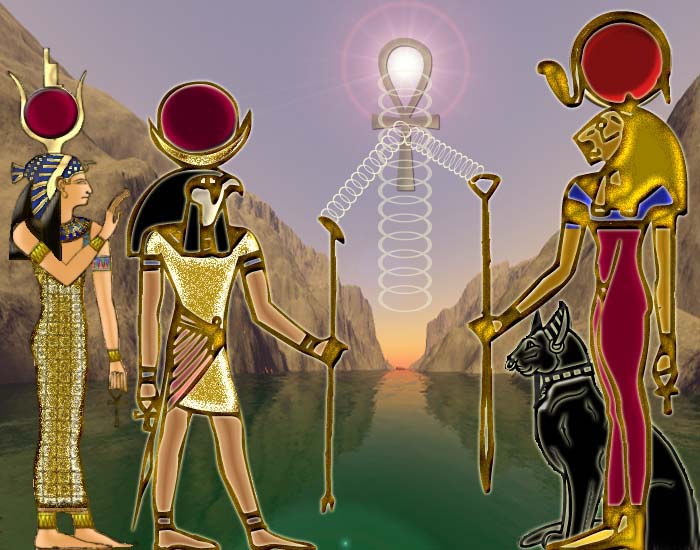
The most influential goddesses were:
Hathor: goddess of nourishment and love,
Bastet: goddess protector of the home,
Sekhmet: goddess of wrath
In 1798, Napoleon Bonaparte led a campaign in Egypt that would be a military fiasco, but which enabled him to return to France with drawings and observations by artists and scientists that he had brought on the expedition.
But it was in 1822 that Egypt became more open to researchers, when the young scientist Jean-Fran¨ois Champollion was able to decrypt the hieroglyphics carved into the Rosetta Stone, which was looted by a French officer during Napoleon's campaign. Beginning with Napoleon's expedition, the wider world developed a passion for Ancient Egypt, and wanted to know more about its history and its culture.
The fascination with Egypt that followed, and with everything that concerned Antiquity, carried a powerful influence. In this era, in Paris, almost all fields of creativity were heavily inspired by the rediscoveries from Antiquity. The arts became redirected along this path, following the fashion for Ancient Egypt down every esthetic route. In this way, clothing styles changed, and women during the Napoleonic Empire adopted styles associated with Ancient Egyptian women, combined with the influence of Ancient Greece and Rome: corsets were abandoned (only temporarily), as well as petticoats, and the raised Empire waist was the popular dress silhouette. Dresses were lighter, and were decorated with motifs from Antiquity, for example palm trees, one of the symbols of the goddess Isis.
